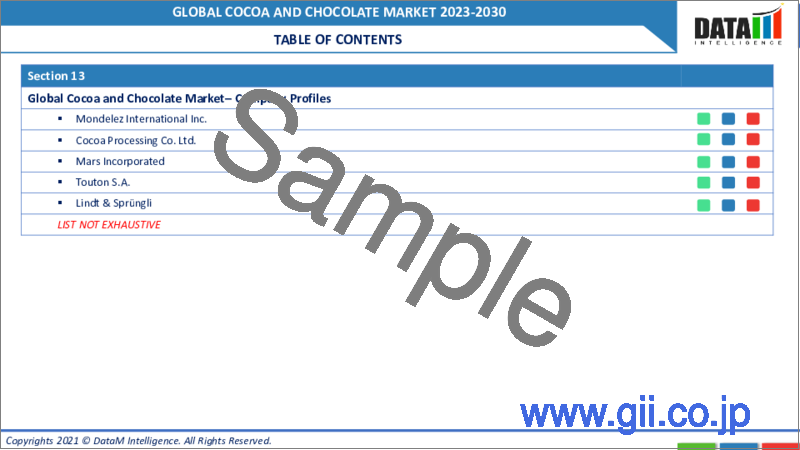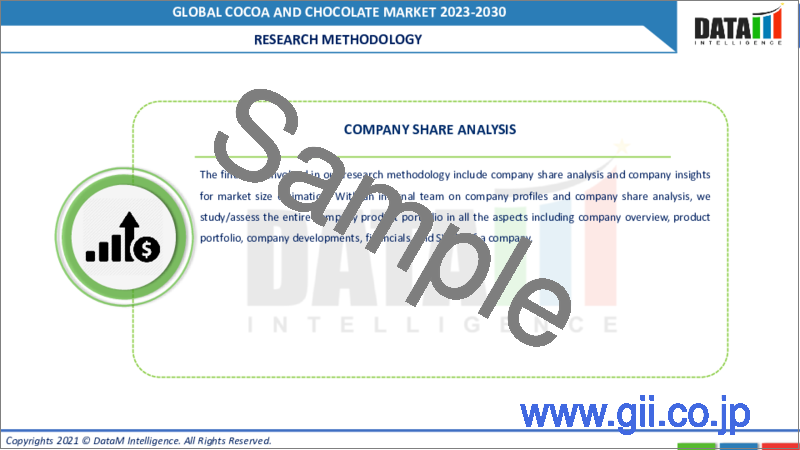|
|
市場調査レポート
商品コード
1304517
ココアとチョコレートの世界市場-2023年~2030年Global Cocoa and Chocolate Market - 2023-2030 |
||||||
カスタマイズ可能
適宜更新あり
|
|||||||
| ココアとチョコレートの世界市場-2023年~2030年 |
|
出版日: 2023年07月07日
発行: DataM Intelligence
ページ情報: 英文 102 Pages
納期: 即日から翌営業日
|
- 全表示
- 概要
- 目次
市場概要
ココアとチョコレートの世界市場は、2022年に4,830万米ドルに達し、2023年から2030年の予測期間にCAGR 4.2%で成長し、2030年には6,710万米ドルに達すると予測されています。
お菓子として、また様々な飲食品用途の原料として、チョコレート製品に対する消費者の需要が高まっていることが、ココアとチョコレート市場の主な促進要因です。チョコレートは世界中で広く楽しまれており、多くの文化や祝祭に欠かせないものとなっています。オーガニック・ココアとチョコレートに対する需要の増加は、オーガニック・ココアとチョコレートがより高品質で、よりクリーンで自然な風味を持つと考えられているためです。Bean to Barとは、カカオ豆から直接チョコレートを作るプロセスを指します。
消費者はますますユニークで高品質なチョコレート体験を求めるようになっています。職人的なチョコレート・ブランドやクラフト・チョコレート・ブランドは、独特の風味や食感を持つ手作りのチョコレートを提供し、人気を集めています。消費者は、よりパーソナライズされた贅沢な体験を提供するこうしたスペシャルティチョコレートにプレミアムを支払うことを厭わないです。
市場力学
世界のチョコレート菓子類消費の増加が市場成長を促進する
消費者の嗜好の変化、可処分所得の増加、食習慣の進化などの要因により、チョコレート菓子類に対する需要は世界的に高まっています。チョコレートは、美味しいお菓子として広く楽しまれており、贅沢やお祝いと結び付けられることが多いです。高級でグルメなチョコレート菓子類への需要が高まっています。消費者は、上質なカカオ豆、独特の風味、職人の技から作られた高品質のチョコレートを求めています。
Dame Cacao社が発表したデータによると、2023年の世界の年間チョコレート消費量は750万トンと予測されています。世界中で77億人が1人当たり2ポンド以下のチョコレートを消費しています。2021年、プレミアム・チョコレートの売上は、2018年と比較して23%増加しました。
チョコレートとココア製品のいくつかの健康上の利点が市場成長を押し上げる
チョコレートとココア製品には抗酸化物質、特にフラボノイドが豊富に含まれており、フリーラジカルや酸化ストレスから体を守るのに役立ちます。これらの抗酸化物質は、心臓病やある種のがんのリスクを減らすなど、様々な健康上の利点に関連しています。特にダークチョコレートは、心臓血管の健康に良い影響を与えることが示されています。血流を改善し、血圧を下げ、血栓形成のリスクを減らし、心臓の健康全般を改善します。
カカオに含まれるフラボノイドやその他の生理活性化合物が、このような心血管系の利点に寄与していると考えられています。チョコレートは気分を高める効果があり、天然の快感ホルモンであるエンドルフィンの分泌を促すことが知られています。また、脳内のセロトニン濃度を高め、気分を改善し、リラックスを促す化合物も含まれています。
チョコレート代用ハンパーの需要増市場成長
多くの消費者が健康や食生活に対する意識を高めているため、より健康的な代替品を提供するチョコレート代替品の需要が増加しています。チョコレートの代用品は、砂糖の含有量が低く、脂肪分が少なく、乳製品やグルテンなどのアレルゲンを含まない場合が多いです。これは、食事制限のある消費者やより健康的な選択肢を求める消費者にアピールします。
ビーガンや植物ベースの食生活の人気の高まりも、代用チョコレートの需要に貢献しています。従来のチョコレート製品には乳製品や動物由来の成分が含まれていることが多く、ビーガンや植物ベースのライフスタイルを実践している人々には適していないです。ココナッツ・ミルク、アーモンド・ミルク、豆乳など、植物由来の成分から作られたチョコレートの代用品は、こうした消費者に実行可能な代替品を提供します。
COVID-19影響分析
COVID-19のロックダウンの実施と拡張により、ココアとチョコレートの商品は世界中の家庭で注目されるようになっています。自宅で仕事をする消費者が増えたため、甘い喜びに対する食欲が急増しています。COVID-19のせいで、世界のココアとチョコレートの初期の売上統計では、ガムとミントのカテゴリーが急減したのに対し、ホワイト・チョコレートのココアとチョコレートとチョコレート以外のココアとチョコレートはともに好調な伸びを示しました。
さらに、COVID-19はココアとチョコレート業界の小売市場を大きく変えました。さまざまな経済圏で製造施設が再開され、市場関係者がサプライチェーンの混乱回復に向けて取り組んでいることから、市場の状況は改善すると予想されます。砂糖とチョコレートのアイテムは快適な食べ物とみなされ、消費者はベーキングのようなより多くの家庭での活動で祝うためにユニークな方法を見つけるように、それは市場にプラスの影響を与えると予想されます。クリック・アンド・コレクトから宅配まで、食料品のオンライン注文を利用する消費者が増えました。ハーシー・カンパニーは、eコマースの売上が大幅に増加し、2020年1月と2月の60%増に対し、2020年3月は120%以上の伸びを示したと述べています。
ロシア・ウクライナ影響分析
ロシア・ウクライナのココアとチョコレート市場は競争が激しく、国内外のブランドが市場シェアを争っています。消費者の嗜好、ブランド・ロイヤルティ、製品の品質、価格戦略が市場力学の形成に重要な役割を果たしています。消費者の嗜好、好み、購買行動の変化は、市場の成長と競合情勢に影響を与える可能性があります。ロシア・ウクライナのココアとチョコレート市場は、消費者の需要や嗜好の変化に後押しされて進化を続けています。市場関係者は、多様な消費者ニーズに対応するため、新しい製品バリエーション、フレーバー、包装形態を導入しています。
より健康的で機能的なチョコレートの選択肢、プレミアムで職人的な製品、持続可能性を重視した取り組みなど、チョコレート分野におけるイノベーションは、市場の成長と消費者の関心に影響を与える可能性があります。スーパーマーケット、コンビニエンスストア、チョコレート専門店、オンライン・プラットフォームなどの小売の状況は、カカオとチョコレート製品へのアクセスや入手のしやすさに大きく影響します。小売チャネル、消費者の買い物パターン、流通戦略の変化は、この地域の市場力学を形成する可能性があります。
目次
第1章 調査手法と調査範囲
第2章 定義と概要
第3章 エグゼクティブサマリー
第4章 市場力学
- 影響要因
- 促進要因
- チョコレート菓子類の世界消費量の増加
- チョコレートとココア製品の様々な健康効果
- 抑制要因
- チョコレート代替品への需要増加
- 機会
- 影響分析
- 促進要因
第5章 産業分析
- ポーターのファイブフォース分析
- サプライチェーン分析
- 価格分析
- 規制分析
第6章 COVID-19分析
第7章 チョコレートの種類別
- ダークチョコレート
- ミルクチョコレート
- ホワイトチョコレート
- フィルドチョコレート
- その他
第8章 カカオの種類別
- ココアバター
- ココアリカー
- ココアパウダー
第9章 用途別
- 化粧品
- 医薬品
- 飲食品
- 菓子類
- その他
第10章 地域別
- 北米
- 米国
- カナダ
- メキシコ
- 欧州
- ドイツ
- 英国
- フランス
- イタリア
- スペイン
- その他欧州
- 南米
- ブラジル
- アルゼンチン
- その他南米
- アジア太平洋
- 中国
- インド
- 日本
- オーストラリア
- その他アジア太平洋地域
- 中東・アフリカ
第11章 競合情勢
- 競合シナリオ
- 市況/シェア分析
- M&A分析
第12章 企業プロファイル
- Nestle S.A
- 会社概要
- 製品ポートフォリオと説明
- 財務概要
- 主な発展
- Cargill Inc.
- Olam International
- Cocoa Processing Co. Ltd.
- Niche Cocoa Industry Ltd.
- Barry Callebaut, AG
- ECOM Agroindustrial Corporation Ltd.
- Fuji Oil Company Ltd.
- Touton S.A.
- BD Associates Ghana Ltd.
第13章 付録
Market Overview
The Global Cocoa and Chocolate Market reached US$ 48.3 million in 2022 and is expected to reach US$ 67.1 million by 2030 growing with a CAGR of 4.2% during the forecast period 2023-2030.
The growing consumer demand for chocolate products, both as a treat and as an ingredient in various food and beverage applications, is a major driver of the cocoa and chocolate market. Chocolate is widely enjoyed across the world and has become an integral part of many cultures and celebrations. Increase in the demand for organic cocoa/chocolate because it is often considered to be of higher quality and has a cleaner, more natural flavor profile. Bean-to-bar refers to the process of making chocolate directly from the cocoa beans.
Consumers are increasingly seeking unique and high-quality chocolate experiences. Artisanal and craft chocolate brands are gaining popularity, offering handcrafted chocolates with distinctive flavors and textures. Consumers are willing to pay a premium for these specialty chocolates that provide a more personalized and indulgent experience.
Market Dynamics
Increasing Global Chocolate Confectionery Consumption to Fuel the Market Growth
The demand for chocolate confectionery products is rising globally, driven by factors such as changing consumer preferences, increasing disposable income, and evolving eating habits. Chocolate is widely enjoyed as a delicious treat and is often associated with indulgence and celebration. There is an increasing demand for premium and gourmet chocolate confectionery products. Consumers are seeking high-quality chocolates made from fine cocoa beans, unique flavors, and artisanal craftsmanship.
According to the Dame Cacao company published data, in 2023, annual global chocolate consumptionis projected at 7.5 million tons in 2023. 7.7 billion people allover the world consume chocolate under 2 pounds per person. In year 2021, sales of premium chocolate grew 23% compared to year 2018.
Several Health Benefits of Chocolate and Cocoa Products Boost Market Growth
Chocolate and cocoa products are rich in antioxidants, particularly flavonoids, which help protect the body against free radicals and oxidative stress. These antioxidants have been linked to various health benefits, including reducing the risk of heart disease and certain types of cancer. Dark chocolate, in particular, has been shown to have positive effects on cardiovascular health. It can help improve blood flow, lower blood pressure, reduce the risk of blood clot formation, and improve overall heart health.
The presence of flavonoids and other bioactive compounds in cocoa is believed to contribute to these cardiovascular benefits. Chocolate is often associated with mood enhancement and is known to stimulate the release of endorphins, which are natural feel-good hormones. It also contains compounds that can boost serotonin levels in the brain, improving mood and promoting relaxation.
Increasing Demand for Chocolate Substitute Hampers Market Growth
Many consumers are increasingly conscious of their health and dietary choices, leading to a rise in demand for chocolate substitutes that offer healthier alternatives. Chocolate substitutes often have lower sugar content, reduced fat content, and are sometimes free from allergens such as dairy or gluten. This appeals to consumers who have dietary restrictions or are seeking healthier options.
The growing popularity of vegan and plant-based diets has also contributed to the demand for chocolate substitutes. Traditional chocolate products often contain dairy or animal-derived ingredients, which are not suitable for vegans or individuals following a plant-based lifestyle. Chocolate substitutes made from plant-based ingredients, such as coconut milk, almond milk, or soy milk, provide a viable alternative for these consumers.
COVID-19 Impact Analysis
Due to COVID-19 lockdown implementations and extensions, Cocoa and Chocolate goods have gained prominence in homes worldwide. Due to more consumers working from home, there has been an upsurge in the appetite for sweet pleasure. Because of COVID-19, early Cocoa and Chocolate sales statistics worldwide showed a sharp fall in the gums and mints category, whereas white chocolate Cocoa and Chocolate and non-chocolate Cocoa and Chocolate both continued to increase well.
Additionally, COVID-19 significantly altered the retail market of the cocoa and chocolate industry. With the manufacturing facilities re-opening in various economies and the market players working towards reinstating the supply chain disruptions, it is anticipated to improve the market situation. As sugar and chocolate items are considered comfort food and consumers find unique ways to celebrate with more at-home activities such as baking, it is expected to impact the market positively. More consumers started using online ordering for groceries, ranging from click-and-collect to home delivery. The Hershey Company stated that its e-commerce sales were up significantly, with growth over 120% in March 2020, versus 60% in January 2020 and February 2020.
Russia-Ukraine Impact Analysis
The cocoa and chocolate market in Russia-Ukraine is competitive, with both domestic and international brands vying for market share. Consumer preferences, brand loyalty, product quality, and pricing strategies play crucial roles in shaping the market dynamics. Changes in consumer tastes, preferences, and buying behaviors can influence market growth and the competitive landscape. The cocoa and chocolate market in Russia-Ukraine continues to evolve, driven by changing consumer demands and preferences. Market players are introducing new product variants, flavors, and packaging formats to cater to diverse consumer needs.
Innovation in the chocolate sector, such as healthier and functional chocolate options, premium and artisanal offerings, and sustainability-focused initiatives, can influence market growth and consumer engagement. The retail landscape, including the presence of supermarkets, convenience stores, specialty chocolate shops, and online platforms, significantly impacts the accessibility and availability of cocoa and chocolate products. Changes in retail channels, consumer shopping patterns, and distribution strategies can shape the market dynamics in the region.
Segment Analysis
The global cocoa and chocolate market is segmented based on chocolate type, cocoa type, application, and region.
Multiple Options Availability in Dark Chocolate Segment Drives Market Growth
The global cocoa and chocolate market by chocolate type has been segmented by dark chocolate, milk chocolate, white chocolate, filled chocolate and others.
Dark chocolate contains no milk solids and has a stronger chocolate flavor than milk chocolate; as a result, dark chocolate is more prone to a dry, chalky texture and a bitter aftertaste. This segment is expected to be driven by key factors such as growing health benefits associated with cocoa-rich dark chocolates, rising demand for premium dark chocolates as gifts, growing online sales, players introducing more limited-edition seasonal chocolates, and expanding marketing initiatives.
Major key players launched new products in the market. For instance, On March 19 2021, Nestle launched sugarless chocolate bar named Nestle Incoa in the market. It is made from 70% dark chocolate bar marketed under Les Recettes de l'Atelier brand. It is made from the cocoa fruit.
Geographical Analysis
Increase in Consumers Demand for Cocoa and Chocolate in North America
North American consumers have a diverse range of preferences when it comes to cocoa and chocolate products. There is a growing interest in high-quality and ethically sourced chocolates, as well as a demand for organic, natural, and healthier options. Dark chocolate, in particular, has gained popularity due to its perceived health benefits. United States and Canada are major share holding countries in the region due to the increase in the consumers demand for the chocolates due to availability of its different types.
Increase in the product launches by major key players in the region helps to boost regional growth over the forecast period. For instance, On May 24, 2022, Ferrero Rocher, a leading chocolate multinational company launched premium chocolate 90g bars in Canada. It is available in the four flavours such as Milk Hazelnut, Dark Hazelnut, White Hazelnut and Dark Hazelnut & Salted Caramel.
Competitive Landscape
The major global players in the market include: Nestle S.A, Cargill Inc., Olam International, Cocoa Processing Co. Ltd., Niche Cocoa Industry Ltd., Barry Callebaut, AG, ECOM Agroindustrial Corporation Ltd., Fuji Oil Company Ltd., Touton S.A., and BD Associates Ghana Ltd.
Why Purchase the Report?
- To visualize the global cocoa and chocolate market segmentation based on chocolate type, cocoa type, application, and region and understand key commercial assets and players.
- Identify commercial opportunities by analyzing trends and co-development.
- Excel data sheet with numerous cocoa and chocolate market-level data points all for segments.
- PDF report consists of a comprehensive analysis after exhaustive qualitative interviews and an in-depth study.
- Product mapping available as Excel consisting of key products of all the major players.
The global cocoa and chocolate market report would provide approximately 58 Tables, 55 Figures and 102 pages.
Target Audience 2023
- Manufacturers/ Buyers
- Industry Investors/Investment Bankers
- Research Professionals
- Emerging Companies
Table of Contents
1. Methodology and Scope
- 1.1. Research Methodology
- 1.2. Research Objective and Scope of the Report
2. Definition and Overview
3. Executive Summary
- 3.1. Snippet by Chocolate Type
- 3.2. Snippet by Cocoa Type
- 3.3. Snippet by Application
- 3.4. Snippet by Region
4. Dynamics
- 4.1. Impacting Factors
- 4.1.1. Drivers
- 4.1.1.1. Increasing Global Chocolate Confectionery Consumption to Fuel the Market Growth
- 4.1.1.2. Several Health Benefits of Chocolate and Cocoa Products Boost Market Growth
- 4.1.2. Restraints
- 4.1.2.1. Increasing Demand for the Chocolate Substitute Hampers Market Growth
- 4.1.3. Opportunity
- 4.1.4. Impact Analysis
- 4.1.1. Drivers
5. Industry Analysis
- 5.1. Porter's Five Force Analysis
- 5.2. Supply Chain Analysis
- 5.3. Pricing Analysis
- 5.4. Regulatory Analysis
6. COVID-19 Analysis
- 6.1. Analysis of COVID-19
- 6.1.1. Scenario Before COVID-19
- 6.1.2. Scenario During COVID-19
- 6.1.3. Scenario Post COVID-19
- 6.2. Pricing Dynamics Amid COVID-19
- 6.3. Demand-Supply Spectrum
- 6.4. Government Initiatives Related to the Market During Pandemic
- 6.5. Manufacturers Strategic Initiatives
- 6.6. Conclusion
7. By Chocolate Type
- 7.1. Introduction
- 7.1.1. Market Size Analysis and Y-o-Y Growth Analysis (%), By Chocolate Type
- 7.1.2. Market Attractiveness Index, By Chocolate Type
- 7.2. Dark Chocolate*
- 7.2.1. Introduction
- 7.2.2. Market Size Analysis and Y-o-Y Growth Analysis (%)
- 7.3. Milk Chocolate
- 7.4. White Chocolate
- 7.5. Filled Chocolate
- 7.6. Others
8. By Cocoa Type
- 8.1. Introduction
- 8.1.1. Market Size Analysis and Y-o-Y Growth Analysis (%), By Cocoa Type
- 8.1.2. Market Attractiveness Index, By Cocoa Type
- 8.2. Cocoa Butter*
- 8.2.1. Introduction
- 8.2.2. Market Size Analysis and Y-o-Y Growth Analysis (%)
- 8.3. Cocoa Liquor
- 8.4. Cocoa Powder
9. By Application
- 9.1. Introduction
- 9.1.1. Market Size Analysis and Y-o-Y Growth Analysis (%), By Application
- 9.1.2. Market Attractiveness Index, By Application
- 9.2. Cosmetics*
- 9.2.1. Introduction
- 9.2.2. Market Size Analysis and Y-o-Y Growth Analysis (%)
- 9.3. Pharmaceuticals
- 9.4. Food & Beverages
- 9.5. Confectionery
- 9.6. Others
10. By Region
- 10.1. Introduction
- 10.1.1. Market Size Analysis and Y-o-Y Growth Analysis (%), By Region
- 10.1.2. Market Attractiveness Index, By Region
- 10.2. North America
- 10.2.1. Introduction
- 10.2.2. Key Region-Specific Dynamics
- 10.2.3. Market Size Analysis and Y-o-Y Growth Analysis (%), By Chocolate Type
- 10.2.4. Market Size Analysis and Y-o-Y Growth Analysis (%), By Cocoa Type
- 10.2.5. Market Size Analysis and Y-o-Y Growth Analysis (%), By Application
- 10.2.6. Market Size Analysis and Y-o-Y Growth Analysis (%), By Country
- 10.2.6.1. The U.S.
- 10.2.6.2. Canada
- 10.2.6.3. Mexico
- 10.3. Europe
- 10.3.1. Introduction
- 10.3.2. Key Region-Specific Dynamics
- 10.3.3. Market Size Analysis and Y-o-Y Growth Analysis (%), By Chocolate Type
- 10.3.4. Market Size Analysis and Y-o-Y Growth Analysis (%), By Cocoa Type
- 10.3.5. Market Size Analysis and Y-o-Y Growth Analysis (%), By Application
- 10.3.6. Market Size Analysis and Y-o-Y Growth Analysis (%), By Country
- 10.3.6.1. Germany
- 10.3.6.2. The U.K.
- 10.3.6.3. France
- 10.3.6.4. Italy
- 10.3.6.5. Spain
- 10.3.6.6. Rest of Europe
- 10.4. South America
- 10.4.1. Introduction
- 10.4.2. Key Region-Specific Dynamics
- 10.4.3. Market Size Analysis and Y-o-Y Growth Analysis (%), By Chocolate Type
- 10.4.4. Market Size Analysis and Y-o-Y Growth Analysis (%), By Cocoa Type
- 10.4.5. Market Size Analysis and Y-o-Y Growth Analysis (%), By Application
- 10.4.6. Market Size Analysis and Y-o-Y Growth Analysis (%), By Country
- 10.4.6.1. Brazil
- 10.4.6.2. Argentina
- 10.4.6.3. Rest of South America
- 10.5. Asia-Pacific
- 10.5.1. Introduction
- 10.5.2. Key Region-Specific Dynamics
- 10.5.3. Market Size Analysis and Y-o-Y Growth Analysis (%), By Chocolate Type
- 10.5.4. Market Size Analysis and Y-o-Y Growth Analysis (%), By Cocoa Type
- 10.5.5. Market Size Analysis and Y-o-Y Growth Analysis (%), By Application
- 10.5.6. Market Size Analysis and Y-o-Y Growth Analysis (%), By Country
- 10.5.6.1. China
- 10.5.6.2. India
- 10.5.6.3. Japan
- 10.5.6.4. Australia
- 10.5.6.5. Rest of Asia-Pacific
- 10.6. Middle East and Africa
- 10.6.1. Introduction
- 10.6.2. Key Region-Specific Dynamics
- 10.6.3. Market Size Analysis and Y-o-Y Growth Analysis (%), By Chocolate Type
- 10.6.4. Market Size Analysis and Y-o-Y Growth Analysis (%), By Cocoa Type
- 10.6.5. Market Size Analysis and Y-o-Y Growth Analysis (%), By Application
11. Competitive Landscape
- 11.1. Competitive Scenario
- 11.2. Market Positioning/Share Analysis
- 11.3. Mergers and Acquisitions Analysis
12. Company Profiles
- 12.1. Nestle S.A*
- 12.1.1. Company Overview
- 12.1.2. Product Portfolio and Description
- 12.1.3. Financial Overview
- 12.1.4. Key Developments
- 12.2. Cargill Inc.
- 12.3. Olam International
- 12.4. Cocoa Processing Co. Ltd.
- 12.5. Niche Cocoa Industry Ltd.
- 12.6. Barry Callebaut, AG
- 12.7. ECOM Agroindustrial Corporation Ltd.
- 12.8. Fuji Oil Company Ltd.
- 12.9. Touton S.A.
- 12.10. BD Associates Ghana Ltd.
LIST NOT EXHAUSTIVE
13. Appendix
- 13.1. About Us and Services
- 13.2. Contact Us





